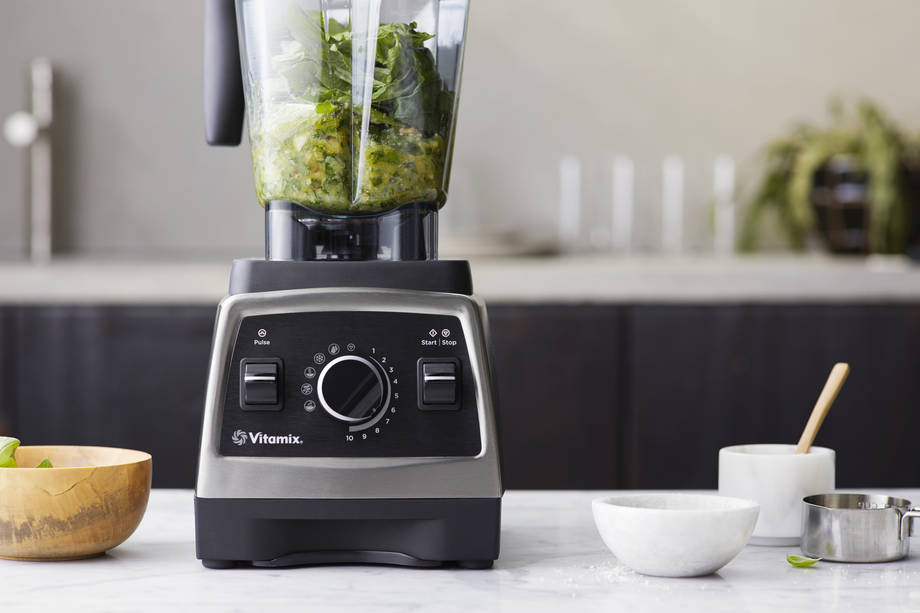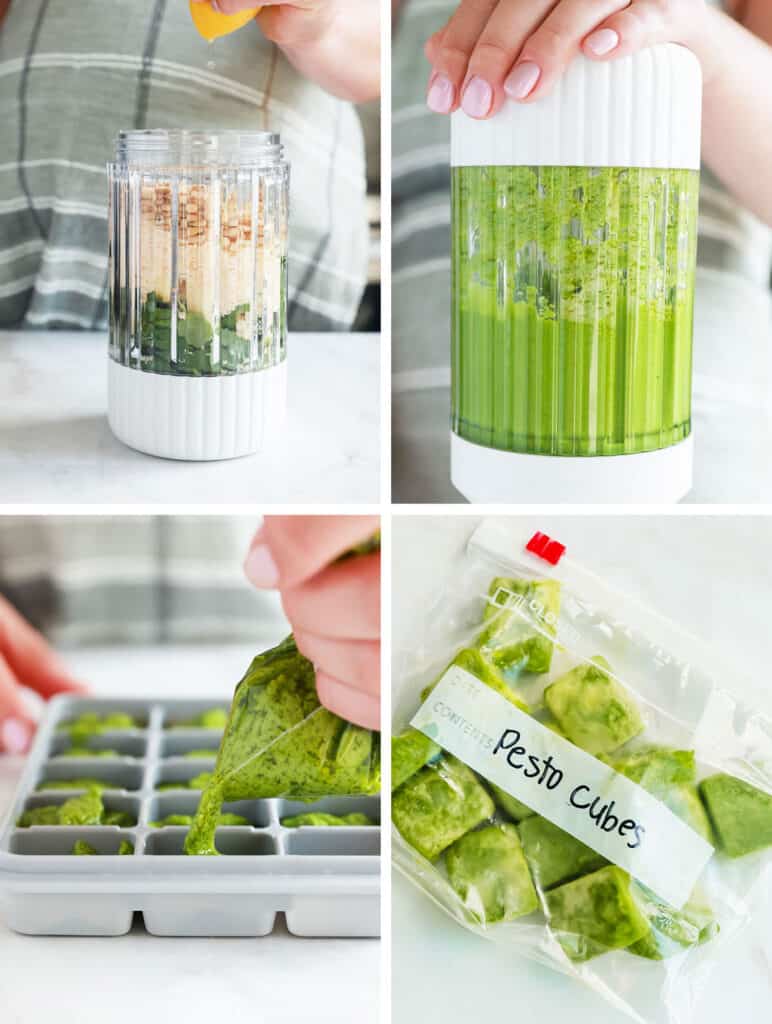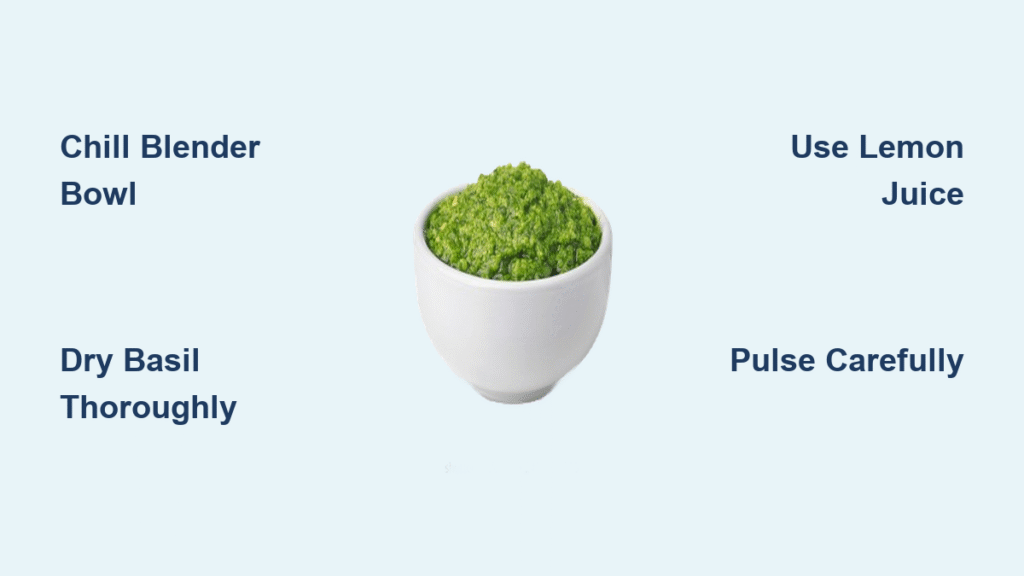That jar of store-bought pesto gathering dust in your pantry? Toss it. Your blender holds the secret to vibrant, restaurant-quality pesto that’s ready before your pasta water boils—no mortar and pestle required. Forget the half-hour chore of traditional methods; with the right technique, you’ll transform fresh basil into emerald-green perfection in under five minutes. And while purists might debate authenticity, one taste of this bright, herbaceous sauce proves blender-made pesto crushes any jarred version on flavor, texture, and freshness.
Whether you’re harvesting basil from your windowsill or grabbing a bunch at the market, this guide delivers foolproof blender pesto every time. You’ll avoid the common pitfalls that turn vibrant green sauce into bitter, separated sludge—water-damaged basil, overheated blades, or imbalanced ratios. Master the simple 2:1:1:1 formula (basil:oil:nuts:cheese), learn why chilling your blender is non-negotiable, and discover how to freeze summer’s bounty for winter pasta nights. Your days of mediocre pesto end now.
Essential Blender Gear That Prevents Disasters

Skip the guesswork that ruins your pesto with the right tools. A high-powered blender like Vitamix delivers silky results in seconds thanks to variable speeds and a tamper, but even standard blenders work if you pulse patiently. Crucially, freeze your blender bowl and blade for 10+ minutes first—this prevents heat buildup that oxidizes basil into muddy olive drab. Water is pesto’s worst enemy, so dry leaves obsessively with a salad spinner followed by paper towels until zero moisture remains.
For storage, choose tall, narrow glass jars over wide containers. The reduced air exposure keeps pesto vibrant green for weeks. Measure every ingredient precisely—eyeballing oil or nuts causes oily separation or pasty texture. And keep a lemon wedge nearby; its juice preserves color better than any trick. With these tools prepped, you’re armed against the three killers of great pesto: moisture, heat, and imprecise ratios.
Why Your Blender Bowl Must Be Ice-Cold
Heat from blending instantly dulls basil’s bright flavor and triggers oxidation. Chilling the bowl and blade for 10 minutes counters this by absorbing friction heat. Without this step, even high-powered blenders can overwork the sauce in 30 seconds. If you lack freezer space, fill the bowl with ice water for 5 minutes before dumping and drying thoroughly. This simple prep preserves the fresh-picked taste that defines killer pesto.
Perfect Ingredient Ratios for Foolproof Flavor
Core Components That Never Fail
- 2 cups packed fresh basil leaves (pressed firmly into cup, stems discarded)
- 1 cup extra virgin olive oil (use mid-range quality—$15-$25 per bottle)
- 1 cup nuts (walnuts or pecans for budget-friendly depth, pine nuts for tradition)
- 1 cup grated Parmesan or Pecorino Romano (omit for dairy-free)
- 3-4 garlic cloves (minced fine to distribute evenly)
- 1 teaspoon salt (add half initially, adjust after blending)
- 1-2 teaspoons fresh lemon juice (critical for color retention)
Smart Swaps When Ingredients Are Scarce
Out of basil? Substitute half with spinach for milder flavor or parsley for year-round brightness. Skip expensive pine nuts—walnuts add earthy richness at one-third the cost. Dairy-free? Omit cheese entirely or use 2 tablespoons nutritional yeast for umami depth. No fresh garlic? Substitute ½ teaspoon garlic powder. These swaps maintain texture and balance without sacrificing authenticity. Never use pre-minced garlic or bottled lemon juice—they introduce bitterness that ruins the sauce.
Step-by-Step Blender Method for Silky Results
Prep Like a Pro Before Blending
Harvest basil by pinching leaves from stems, keeping only tender tips. Wash in cold water with a splash of lemon juice to remove dirt and chemical residues that cause bitterness. Dry leaves until bone-dry using a salad spinner, then pat with paper towels—any moisture creates separation. Measure all ingredients into small bowls; blenders work too fast for mid-process measuring.
Standard Blender Technique (No Tamper)
- Layer dry ingredients: Add basil, nuts, garlic, cheese, and salt to blender
- Pulse while drizzling: Start on low speed, slowly pour oil through lid opening
- Blend 30 seconds max: Stop immediately if mixture heats up—scrape sides once
Critical tip: If your blender stalls, add half the oil first, blend until smooth, then slowly incorporate remaining oil. Over-blending creates heat that turns pesto brown within hours.
High-Powered Blender Method (With Tamper)
- Oil first: Pour all olive oil into chilled blender
- Blend base: Add garlic, cheese, salt—blend 10 seconds until creamy
- Pack basil: Add leaves all at once, use tamper to push into blades on high
- Finish with nuts: Blend 15 seconds until nuts emulsify completely
Work fast—total blending time must stay under 30 seconds. The tamper’s magic lies in keeping basil moving without stopping the motor, preventing hot spots.
Storage Secrets for Months of Fresh Flavor

Refrigerator Method That Prevents Browning
Store pesto in tall glass jars topped with a ¼-inch layer of olive oil to seal out air. This creates an oxygen barrier that maintains vibrant color for 1-2 weeks. Always remove jars from the fridge 1 hour before use—warming cold pesto separates the cheese. Never store in plastic containers; they absorb flavors and accelerate oxidation.
Freezer Strategy for Year-Round Enjoyment
Portion pesto into ice cube trays or silicone muffin cups, freeze solid, then transfer cubes to labeled freezer bags. For best results, omit cheese before freezing and stir in fresh Parmesan when thawed. Properly frozen pesto lasts 12 months—thaw overnight in the fridge. Pro move: Fill 4-ounce jars, top with oil, freeze upright, and gift with a ribbon for instant gourmet presents.
Troubleshooting Guide for Perfect Pesto Every Time

Fixing Texture Catastrophes Immediately
Too thick? Drizzle in 1 tablespoon olive oil while pulsing. Too oily? Add ¼ cup fresh basil and blend 10 seconds. Grainy nuts? Blend nuts alone first into paste, then add remaining ingredients. If separation occurs, emulsify by blending with 2 tablespoons hot pasta water—this creates a creamy sauce that clings to noodles.
Solving Flavor Failures in Seconds
Bitter taste? Your basil likely had chemical residues—switch to organic next time. Bland flavor? Stir in ¼ teaspoon salt; pesto intensifies as it sits. Overpowering garlic? Blend in extra basil and nuts to mellow the bite. Always taste before serving—flavors concentrate during storage.
Color Rescue Techniques for Vibrant Green Sauce
Brown pesto means oxidation won. Next time, dry leaves more thoroughly and add extra lemon juice. If your blender overheated, chill equipment longer and pulse instead of continuous blending. Dark spots? Simply scrape off affected portions—the rest remains safe and delicious. Remember: cold tools + dry basil + lemon juice = emerald perfection.
Creative Uses That Transform Ordinary Meals
Skip the pasta rut with these pro applications. Toss hot gnocchi with pesto for 2-minute gourmet dinner, or spread it under mozzarella on pizza for a basil-forward base. Upgrade grilled cheese by slathering pesto between sourdough slices before buttering the bread. For breakfast, swirl 2 tablespoons into scrambled eggs with extra Parmesan—creamy and luxurious.
Try these unexpected twists: marinate chicken breasts in pesto 30 minutes before grilling, spread over cream cheese for instant crackers appetizers, or layer in turkey sandwiches for a flavor explosion. Even dollop on roasted vegetables—the acidity cuts through richness perfectly.
Mastering how to make pesto sauce in a blender means garden-fresh flavor year-round with zero fuss. Your blender’s speed and power outperform tedious mortar-and-pestle methods while avoiding store-bought compromises. Freeze summer basil harvests in portioned cubes, and you’ll enjoy vibrant, emerald-green sauce straight through winter. Remember the golden rule: cold equipment, bone-dry basil, and precise 2:1:1:1 ratios guarantee success every time. One taste of this bright, herbaceous sauce and you’ll never touch a jar again—your pasta nights just got a permanent upgrade.





